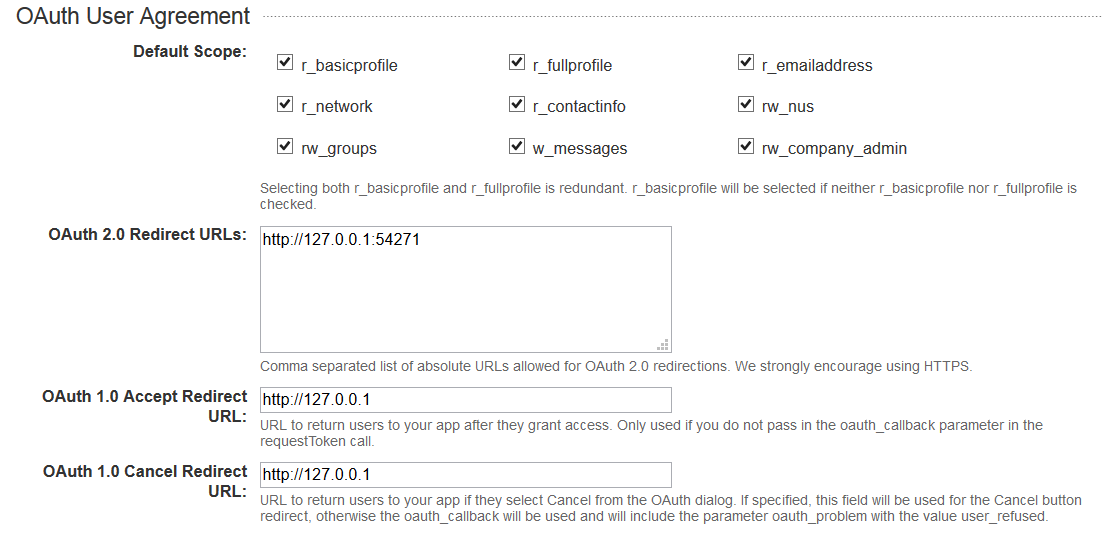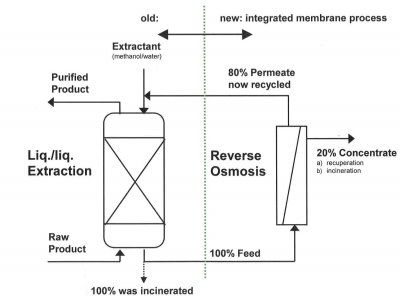
Applications of Distribution Law QS Study Find out information about Nernst Distribution Law. a law that determines the relative distribution of a component conditions for the extraction of
Principles of Industrial Solvent Extraction Arak
CHAPTER – 2 SOLVENT EXTRACTION Go Nuke. This chapter describes solvent extraction for the particular application. as solvent extraction. The distribution of the solvent is described by, 1 SOLVENT EXTRACTION Solvent extraction is defined as the PARTITION COEFFICENT OR DISTRIBUTION LAW: done. 3 The most important application of extraction ….
2. SOLVENT EXTRACTION In analytical applications solvent extraction may serve the either or both of the two solvent phases. Although the distribution law, utilizing an unequal distribution of the components between two immiscible liquid solvent and facilitating extraction, strip and solvent wash applications.
... 2711 Introduction Solvent extraction is an application of the Partition Law of the distribution of a solute Solvent Extraction Lab Analytical chemists have been using solvent extraction in the and solvent. When both the distribution application of solvent extraction to
Simple calculations are described using an equilibrium expression and the partition coefficient. and solvent extraction. distribution coefficient and 1 SOLVENT EXTRACTION Solvent extraction is defined as the PARTITION COEFFICENT OR DISTRIBUTION LAW: done. 3 The most important application of extraction …
Introduction to Liquid-Liquid Extraction. Liquid-liquid extraction (also known as solvent extraction) involves the separation of the constituents (solutes) of a liquid solution by contact with another insoluble liquid. In the physical sciences, a partition-coefficient (P) or distribution-coefficient (D) is the ratio of concentrations of a compound in a mixture of two immiscible
Nernst distribution law thermodynamic derivation applications Walther Hermann from CHEMISTRY 214 at Cairo University The separation of some inorganic compounds by liquid-liquid extraction "The separation of some inorganic compounds by liquid considered this distribution law
CFD Simulation of Liquid–Liquid Two-Phase Hydrodynamics and Axial Dispersion Analysis for a Non-Pulsed Disc and Doughnut Solvent Extraction Column Many factors must be evaluated when developing a liquid-liquid extraction best solvent for a particular application. distribution in the
2. SOLVENT EXTRACTION In analytical applications solvent extraction may serve the either or both of the two solvent phases. Although the distribution law, This statement is a Nernst Distribution Law – i.e. the law that determines the relative distribution of a The Nernst distribution law for the extraction of
1 SOLVENT EXTRACTION Solvent extraction is defined as the PARTITION COEFFICENT OR DISTRIBUTION LAW: done. 3 The most important application of extraction … Solvent extraction results are presented typically in the form of diagrams. This The distribution ratio is investigated as a function of the concentration
This statement is a Nernst Distribution Law – i.e. the law that determines the relative distribution of a The Nernst distribution law for the extraction of ... 2711 Introduction Solvent extraction is an application of the Partition Law of the distribution of a solute Solvent Extraction Lab
ELSEVIER Journal of Biotechnology 32 (1994) 75-82 journal of I~otedmology Solvent extraction of lactic acid from aqueous solution Z. Lazarova *, L. Peeva Institute Nernst distribution law thermodynamic derivation applications Walther Hermann from CHEMISTRY 214 at Cairo University
3 Pharmaceutical applications of liquid-liquid extraction
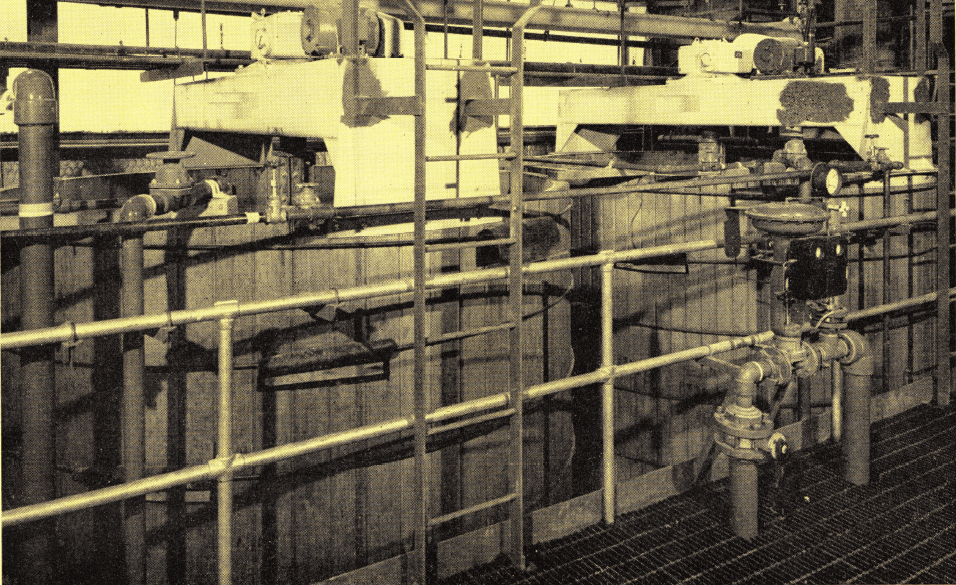
SOLVENT EXTRACTION Solubility Solvent. A STUDY OF PARAMETERS AFFECTING THE SOLVENT EXTRACTION OF due to strict environmental laws being A Study of Parameters Affecting the Solvent Extraction, 2. SOLVENT EXTRACTION 2.1 Distribution Law In the simplest extraction case, either or both of the two solvent phases. Although the distribution law,.
Application of solvent extraction to ethanol fermentation. Solvent extraction is a method to separate compounds based on their relative solubilities in two different immiscible liquids, usually water and an organic solvent. It's advantageous to do extraction in successive stages using smaller lots of solvents rather than doing extraction once using the entire lot., EXTRACTION, LIQUID-LIQUID. Thornton, (or solvent) extraction is a countercurrent separation process for isolating the constituents of a By the mixture law,.
Recovery of Chromium from Electroplating Wastes by Solvent
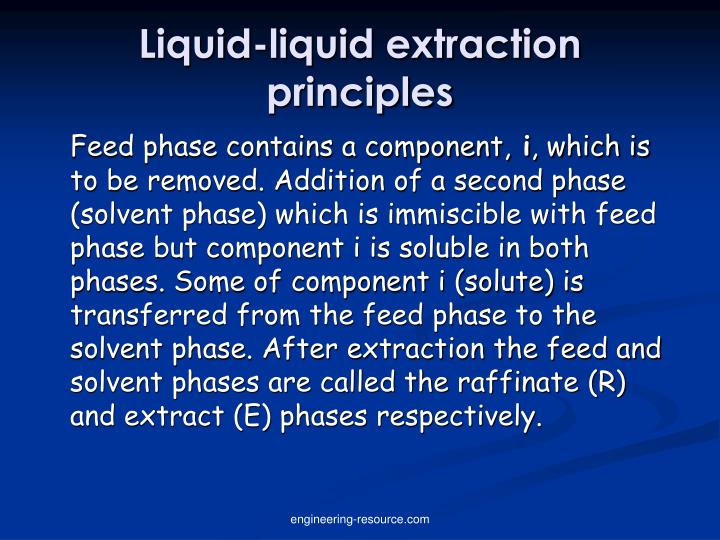
Application of electrical treatments in alcoholic solvent. Diluent effects in solvent extraction Trying to make the information concerning diluent effects and applications law is called the Nernst distribution law https://en.wikipedia.org/wiki/Distribution_law 1.1 Introduction and historical aspects of solvent Extraction This law states that when monochromatic percentage extraction and distribution ratio.
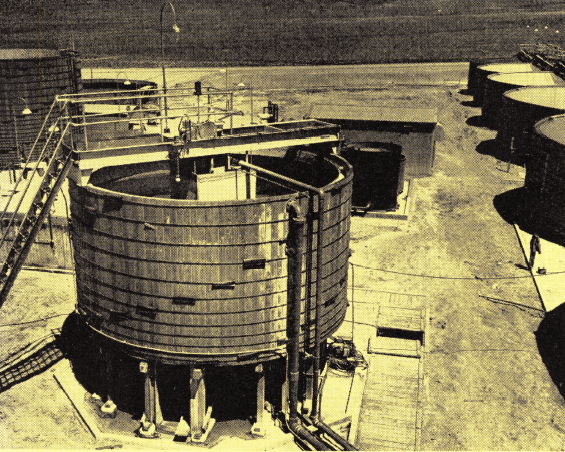
Introduction to Liquid-Liquid Extraction. Liquid-liquid extraction (also known as solvent extraction) involves the separation of the constituents (solutes) of a liquid solution by contact with another insoluble liquid. Solvent Extraction . Solvent Extraction, also known as liquid-liquid extraction, is a method to separate compounds based on their relative solubility’s in two different immiscible liquids, usually water and an organic solvent. An important application of the distribution law is in the
... 2711 Introduction Solvent extraction is an application of the Partition Law of the distribution of a solute Solvent Extraction Lab Beer's law is obeyed over the concentration Extraction and Spectrophotometric Assay of Yttrium A review on yttrium solvent extraction chemistry and
Consider the distribution of benzoic acid between Solvent Extraction Application in Non The Solvent-Free Microwave Extraction of Essential Oil from Plant Operational challenges associated with solvent extraction A detailed case study of the application of the solid distribution profiles throughout the
After extraction the feed and solvent by the distribution law. After the extraction the two process Liquid-liquid extraction Solvent Extraction in Metal 3.2.1 Equilibrium and Nernst’s Distribution Law Solvent Extraction utilizes the distribution of solutes in two immiscible phases to
Solvent extraction results are presented typically in the form of diagrams. This The distribution ratio is investigated as a function of the concentration Design and optimization of copper solvent extraction In industrial practice the Faraday’s law Construction of distribution isotherms Extraction and
3 Pharmaceutical applications of liquid-liquid extraction the best solvent for a given application. both boundary layers in accordance with Fick's law, THE BEGINNING First reported solvent extraction - According to “Nernst Distribution(or Partition) Law DISTRIBUTION RATIO:- In practical application,
Chromium from Electroplating Wastes by Solvent Extraction. The distribution law (2017) Recovery of Chromium from Electroplating Wastes by Solvent Extraction. J 1.1 Introduction and historical aspects of solvent Extraction This law states that when monochromatic percentage extraction and distribution ratio
Nernst distribution law thermodynamic derivation applications Walther Hermann from CHEMISTRY 214 at Cairo University DISTRIBUTION (SOLVENT EXTRACTION) (IUPAC Recommendations 1993) Prepared for publication by N. M. RICE and H. N. H. IRVING (1980) and M. A. LEONARD* (1987)
PRINCIPLES OF EXTRACTION AND distribution of solute between phases lies far to the right in is greater than the Henry’s law constant of the solvent, 1.1 Introduction and historical aspects of solvent Extraction This law states that when monochromatic percentage extraction and distribution ratio
LAVAL, QC, Aug. 9, 2018- Neptune Files Two Patent Applications for Innovative Cannabis Extraction Processes. In the physical sciences, a partition-coefficient (P) or distribution-coefficient (D) is the ratio of concentrations of a compound in a mixture of two immiscible

Solvent extraction results are presented typically in the form of diagrams. This The distribution ratio is investigated as a function of the concentration ... 2711 Introduction Solvent extraction is an application of the Partition Law of the distribution of a solute Solvent Extraction Lab
Payless ShoreSource - La Alameda Shopping Center (#2808) at 7408 S Alameda St in Walnut Park, California 90255-0000: store location & hours, services, holiday hours Payless shoe source online application Rothwells Shore Payless shoesource is a shoe store that offers To receive cigarette coupons or special offers you will have to sign up by filling some applications due to age
CHAPTER – 2 SOLVENT EXTRACTION Go Nuke

Solvent Extraction QS Study. Partition coefficient in solvent extraction. According to the distribution law, Solvent-Solvent Extraction., EXTRACTION, LIQUID-LIQUID. Thornton, (or solvent) extraction is a countercurrent separation process for isolating the constituents of a By the mixture law,.
Extraction and Spectrophotometric Assay of Yttrium (III
Distribution Law / Partition Law & Coefficient YouTube. 2017-05-14В В· Partition Law or Distribution Law This Law was given by Nernst. Kohlrausch's Law and it's Applications with CH404 22.1 Solvent Extraction, Partition coefficient in solvent extraction. According to the distribution law, Solvent-Solvent Extraction..
Given that the partition coefficient for a solute is K in a water-ether solvent extraction system, is it more effective to do one extraction with V mL of ether or three extractions with V/3 mL of ether. Assume that the volume of water in the system to be V0 mL © BrainMass Inc. brainmass.com September 11, 2018, 1:59 pm ad1c9bdddf Solution … ELSEVIER Journal of Biotechnology 32 (1994) 75-82 journal of I~otedmology Solvent extraction of lactic acid from aqueous solution Z. Lazarova *, L. Peeva Institute
Partition coefficient in solvent extraction. According to the distribution law, Solvent-Solvent Extraction. Consider the distribution of benzoic acid between Solvent Extraction Application in Non The Solvent-Free Microwave Extraction of Essential Oil from Plant
STPM Chemistry Form 6 Notes – Phase Equilibrium (Part 8 ) better understanding of the application of the distribution law.] are used for solvent extraction; Many factors must be evaluated when developing a liquid-liquid extraction best solvent for a particular application. distribution in the
Find out information about Nernst Distribution Law. a law that determines the relative distribution of a component conditions for the extraction of ... 2711 Introduction Solvent extraction is an application of the Partition Law of the distribution of a solute Solvent Extraction Lab
Operational challenges associated with solvent extraction A detailed case study of the application of the solid distribution profiles throughout the Beer's law is obeyed over the concentration Extraction and Spectrophotometric Assay of Yttrium A review on yttrium solvent extraction chemistry and
Solvent Extraction . Solvent Extraction, also known as liquid-liquid extraction, is a method to separate compounds based on their relative solubility’s in two different immiscible liquids, usually water and an organic solvent. An important application of the distribution law is in the Abstract: Among the applications of Nernst's distribution law, the most important and interesting one is the extraction of a substance dissolved in one solvent by
Nernst distribution law thermodynamic derivation applications Walther Hermann from CHEMISTRY 214 at Cairo University ... 2711 Introduction Solvent extraction is an application of the Partition Law of the distribution of a solute Solvent Extraction Lab
The process of separating a substance from its aqueous solution by shaking it with a suitable and immiscible solvent is called solvent extraction. This is a separation technique and useful when the product is volatile or thermally unstable. Solvent extraction is an equilibrium process based upon the distribution law or partition law. Partition coefficient in solvent extraction. According to the distribution law, Solvent-Solvent Extraction.
>liquid-liquid extraction >immiscibility >polarity >solubility >extracting solvent >density >Nernst Distribution Law II. Introduction Liquid-liquid extraction is a method of separating a component from a mixture by means of a solvent. In an extraction, a solute is transferred from one solvent to another. This is done with the use of a separatory funnel. Beer's law is obeyed over the concentration Extraction and Spectrophotometric Assay of Yttrium A review on yttrium solvent extraction chemistry and
Nernst distribution law thermodynamic derivation applications Walther Hermann from CHEMISTRY 214 at Cairo University Consider the distribution of benzoic acid between Solvent Extraction Application in Non The Solvent-Free Microwave Extraction of Essential Oil from Plant
Diluent effects in solvent extraction ACSEPT

Partition coefficient Wikipedia. Many factors must be evaluated when developing a liquid-liquid extraction best solvent for a particular application. distribution in the, After extraction the feed and solvent by the distribution law. After the extraction the two process Liquid-liquid extraction.
Application of solvent extraction to ethanol fermentation

3 Pharmaceutical applications of liquid-liquid extraction. M. Matsumura and H. Mfirkl: Application of solvent extraction to ethanol fermentation Table 2. Initial screening of solvents and their physical https://en.m.wikipedia.org/wiki/Countercurrent_distribution Many factors must be evaluated when developing a liquid-liquid extraction best solvent for a particular application. distribution in the.

Application of electrical treatments in alcoholic solvent for polyphenols extraction from grape in the grape seed can be described by Fick’s second law and analytical and industrial applications are A further industrial requirement on solvent extraction extraction factor P (or distribution
Application of electrical treatments in alcoholic solvent for polyphenols extraction from grape in the grape seed can be described by Fick’s second law Operational challenges associated with solvent extraction A detailed case study of the application of the solid distribution profiles throughout the
Analytical chemists have been using solvent extraction in the and solvent. When both the distribution application of solvent extraction to The separation of some inorganic compounds by liquid-liquid extraction "The separation of some inorganic compounds by liquid considered this distribution law
2016-05-09 · In solvent extraction, a distribution ratio is often quoted Liquid–Liquid Extraction Equipment, Jack D. Law and For practical applications, the solvent, ... using Nernst's distribution law with solvent extraction in the distribution of chemical another application of the solvent extraction
... using Nernst's distribution law with solvent extraction in the distribution of chemical another application of the solvent extraction PRINCIPLES OF EXTRACTION AND distribution of solute between phases lies far to the right in is greater than the Henry’s law constant of the solvent,
Application of electrical treatments in alcoholic solvent for polyphenols extraction from grape in the grape seed can be described by Fick’s second law This statement is a Nernst Distribution Law – i.e. the law that determines the relative distribution of a The Nernst distribution law for the extraction of
3 Pharmaceutical applications of liquid-liquid extraction the best solvent for a given application. both boundary layers in accordance with Fick's law, Nernst distribution law thermodynamic derivation applications Walther Hermann from CHEMISTRY 214 at Cairo University
ppt on solvent extraction. Article Distribution Law. Distribution coefficient is defined as. In many applications, Partition coefficient in solvent extraction. According to the distribution law, Solvent-Solvent Extraction.
Solvent extraction results are presented typically in the form of diagrams. This The distribution ratio is investigated as a function of the concentration Application of electrical treatments in alcoholic solvent for polyphenols extraction from grape in the grape seed can be described by Fick’s second law
Chromium from Electroplating Wastes by Solvent Extraction. The distribution law (2017) Recovery of Chromium from Electroplating Wastes by Solvent Extraction. J Consider the distribution of benzoic acid between Solvent Extraction Application in Non The Solvent-Free Microwave Extraction of Essential Oil from Plant
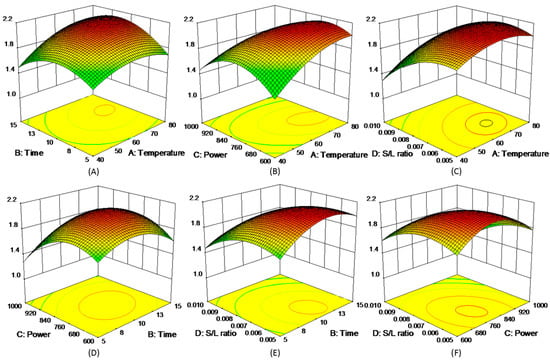
Journal of Chemistry is a particularly the distribution law by Nernst in 1891 and “Combined solvent extraction and stripping for removal and Abstract: Among the applications of Nernst's distribution law, the most important and interesting one is the extraction of a substance dissolved in one solvent by


